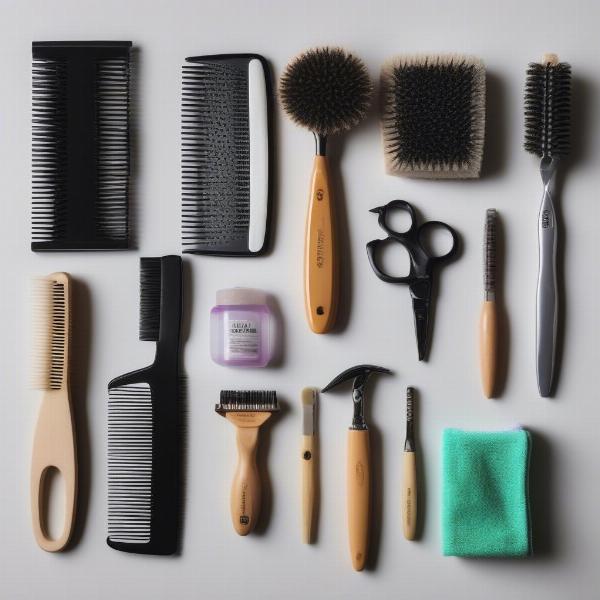All dogs grooming is an essential aspect of responsible dog ownership. Whether you have a fluffy Pomeranian or a sleek Doberman, regular grooming contributes significantly to your dog’s health, hygiene, and overall well-being. This guide will delve into the importance of all dogs grooming and provide practical tips for every breed and coat type.
Understanding the Importance of All Dogs Grooming
Grooming isn’t just about making your dog look good; it plays a vital role in their physical health. Regular brushing removes dead hair and prevents matting, which can lead to skin irritations. Grooming also allows you to check for parasites like fleas and ticks, and identify any skin conditions early on. Beyond the physical benefits, grooming provides a wonderful opportunity to bond with your canine companion.
Essential Grooming Tools for All Dogs
Having the right tools is crucial for effective grooming. A basic kit should include:
- Brushes: Different coat types require different brushes. Slicker brushes are ideal for removing loose hair, while bristle brushes are better for distributing natural oils and adding shine. For dogs with long, thick coats, de-matting tools are essential.
- Combs: Combs help to detangle and remove mats, especially in areas prone to tangling, like behind the ears and under the legs.
- Nail clippers: Keeping your dog’s nails trimmed is important for their comfort and mobility.
- Dog shampoo and conditioner: Choose a pH-balanced shampoo and conditioner specifically formulated for dogs.
- Towels: Microfiber towels are particularly absorbent and helpful for drying your dog’s coat.
 Essential Dog Grooming Tools Kit
Essential Dog Grooming Tools Kit
Grooming Based on Coat Type
Different coat types require different grooming approaches.
Short-coated Dogs
Short-coated breeds like Chihuahuas and Beagles require less frequent brushing, typically once a week. Focus on removing loose hair and distributing natural oils.
Long-coated Dogs
Long-coated breeds like Golden Retrievers and Afghan Hounds need daily brushing to prevent matting and tangling. Pay particular attention to areas prone to matting, such as behind the ears and under the legs. dog jammies for large dogs can help keep their coats clean between grooming sessions.
Double-coated Dogs
Double-coated breeds like Huskies and German Shepherds have a thick undercoat and a longer outer coat. Regular brushing is essential to remove loose undercoat, especially during shedding season.
Bathing Your Dog
How often you bathe your dog depends on their breed, lifestyle, and coat type. Over-bathing can strip their skin of natural oils, so aim for bathing every 4-8 weeks unless they get particularly dirty. Always use a dog-specific shampoo and conditioner.
Nail Trimming
Regular nail trimming is essential. Overgrown nails can cause discomfort and lead to joint problems. If you’re uncomfortable trimming your dog’s nails yourself, a groomer or veterinarian can do it for you. A grooming table for small dogs can be helpful for making grooming tasks easier.
Professional Grooming
While regular at-home grooming is crucial, professional grooming offers additional benefits. Groomers have the expertise and tools to handle more complex tasks like de-matting, trimming, and styling. all 4 dogs grooming and all 4 dogs grooming blaine are examples of professional grooming services. Consider professional grooming every few months or as needed.
Conclusion
All dogs grooming is a vital part of responsible dog ownership. By understanding your dog’s specific grooming needs and implementing a regular grooming routine, you can contribute significantly to their health, happiness, and overall well-being. Remember, grooming is not just about aesthetics; it’s about building a stronger bond with your furry friend.
FAQ
- How often should I groom my dog? The frequency depends on your dog’s breed and coat type, ranging from weekly to daily.
- What are the essential grooming tools? A basic kit should include brushes, combs, nail clippers, dog shampoo and conditioner, and towels.
- Can I groom my dog myself? Yes, regular at-home grooming is essential, but professional grooming is recommended for more complex tasks.
- How often should I bathe my dog? Every 4-8 weeks is generally sufficient, unless your dog gets excessively dirty.
- How do I trim my dog’s nails? Use dog-specific nail clippers and be careful not to cut the quick. If you’re unsure, consult a groomer or veterinarian.
- Where can I find more information on dog breeds? Check out our resources on dogs for sale rockhampton.
- What are the benefits of professional grooming? Groomers have the expertise and tools for complex tasks like de-matting, trimming, and styling.
ILM Dog is your trusted resource for all things dog-related. We offer expert advice on dog breeds, health, training, nutrition, grooming, and much more. From puppy care to senior dog care, we cover every stage of your dog’s life. We also offer guidance on products and accessories to enhance your dog’s well-being. Contact us at [email protected] or +44 20-3965-8624 for personalized advice. Visit ILM Dog for a wealth of information and resources.